It's Easy Eating Greens: Dispatch from Jury Duty in Chinatown
Justice and Chinese Greens Are Being Served
I hope you enjoy Issue #46, a dispatch from jury duty in downtown Manhattan. As always, I extend my thanks to all my readers and subscribers. Whether you are celebrating Passover, Easter, or Ramadan, or just welcoming spring and going about your business. —Mitchell
If you’ve been following along with my @KitchenSense Instagram, you know that I’ve been on jury duty this week. I know people spend their lives trying to get out of jury duty, but I find it really interesting to see firsthand how our justice systems works (or doesn’t). My forensics vocabulary has increased, as has my understanding of the inner workings of the complex confounding city where I live. To be honest, this time it also makes me feel profoundly sad. I’ve been overwhelmed by how our deep-rooted, systemic inequality impacts people who are just going about their daily lives.
Aside: I you aren’t following me on Instagram, you should be because my feed foreshadows what’s coming up in this newsletter. Also, if you are a subscriber and you see something that I’ve cooked that particularly interests you, you can request that I publish the recipe.
Another upside of jury duty in Manhattan is the location of the courts, which is at the geographical nexus of TriBeCa, SoHo, and Chinatown. This makes for endless lunch options and some good food shopping. Although I’ve hit a few bakeries and stores in TriBeCa and SoHo, I’ve spent most of my free time exploring the restaurants and shops of Chinatown.

The eating has been very good. (I’ll do a jury duty dining round-up for paid subscribers soon.) So has the food shopping, both in stores and along the streets. (Subscribers can see some of my favorite Chinatown shops here.) There are inexplicably still giant, delicious oranges to be had everywhere. Mangos are in season. And, as always, there are mountains of Asian greens.
I love Asian greens of all kinds. At any given moment there are pounds of them in my fridge. I steam handfuls whole to eat with oyster sauce for lunch and chop them up to stir fry them with garlic and ginger for dinner. While I’m in no way an expert on the different types greens—I know my gai lan from my bok choy, but that’s about it—I’ve gotten pretty good at cooking them up quickly into tasty sides. From our Chinese grocer in Ithaca, New York, I particularly like what they call interchangeably “Shanghai bok choy” or “bok choy tips,” which are long, thin bok choy, more in the shape of Chinese broccoli than the more common little cabbages. For a guide to what’s what, I’ll direct you to this great Field Guide to Asian Greens on SeriousEats.com. But I want to share with you a few ways to cook them.
General Notes about Cleaning and Cooking Greens
No matter which greens you buy, they tend to be sandy. All of these greens need to be soaked in and lifted out of a large amount of water. I use my salad spinner and insert to soak and drain them (no need to take them for a spin in you are boiling them, but I you are stir frying them you’ll want to whip all the water off). If you have small, compact heads of baby bok choy it’s best to slice them lengthwise in half before soaking to release any sand in their core. For longer greens, like gai lan or Shanghai bok choy (see photo), I cut off about ½ inch of the stem end, which often detaches some of the longer leaves, and soak them whole. The longer they soak, the better. Be sure to lift the greens out of the water, allowing the sand to stay behind, rather than dumping and draining them, which can pour the sand right back on top. If you notice a significant amount of sand has fallen to the bottom of your basin, soak them another time or two to make sure they are clean. Nothing causes me to lose my appetite than a mouthful of grit.
When it comes to cooking your greens, most places in Chinatown seem to either boil their greens in one of the large vats of water or stock they have gurgling away for other purposes, noodles and such, or stir-fry them. In my opinion, the former is easiest. Rather than bring a giant pot of water to a boil just to cook some greens, which is both time consuming and wasteful, I usually use a modified shallow boiling/steaming technique, whereby I put about an inch of water in a tall pot or deep frying pan, bring it quickly to a boil, pile in the greens and cover tightly to cook/steam them for a few minutes until tender. (This how my mother (over-) cooked her broccoli her entire life.) If I’m boiling water for noodles anyway, I’ll cook the greens in that same pot of water. For even cooking and serving later, it’s best to keep the greens more or less aligned in the same direction while cooking.
Note that it’s not common to salt the cooking water for Asian greens the way it is when you blanch vegetables for French or Italian recipes. I’m not sure why, but the greens do have inherent, faint saltiness to my taste, and the soy, oyster or other sauces you are going to use on them later contribute plenty of salinity. However I cook my greens, I save the cooking water in the fridge and use it as a light vegetable stock. This is another reason it’s helpful that the water isn’t salted.
TECHNIQUE: Steamed Chinese Greens with Oyster Sauce
This is the easiest technique for cooking Asian greens. It’s hard to give a recipe. It replicates the pile of cooked greens you get in noodle shops in Chinatown. It works best with gai lan or “Chinese broccoli”or other greens with thicker stems. Look for gai lan with stems that are no more than ½-inch thick. Since the only flavoring or condiment is oyster sauce, it behooves you to find a good one. I’ve tried so many and have settled on a Thai oyster sauce by Megachef (see photo) as my favorite for its complex flavor that’s not too salty or too sweet. It also relies on natural umami from the fermentation of the oysters, rather than the addition of MSG. I’ve been looking for years for a recipe to make my own oyster sauce, but I haven’t found one I trust. Please let me know if you have one.
Lop off about a ½ inch of stem ends of your greens and soak them in a basin of cold water. Lift them from the water and drain. Repeat if you see a lot of sand at the bottom of the basin. Bring about 1 inch of water to boil in a deep pot or frying pan that is big enough to hold all your greens. (They will shrink considerably, mind you.) Once boiling, add the drained greens and cover tightly. Let cook for 2 to 5 minutes, depending on the thickness of the stems. While I don’t think these greens should be mushy, I think they are best just past what might be considered “al dente.” You can see when they are done by the deeper green color the stems take on and wilted leaves. If you aren’t sure, taste one and cook it to your liking.
When done, use tongs to lift and drain the greens before placing them directly on a serving plate. Drain off any water that has accumulated on the plate. While still piping hot, drizzle over some of the oyster sauce and serve.
I’ll note that Nate doesn’t like it when I serve greens whole like this. He refers to them as “those chokey greens.” For him I usually chop and stir fry them.
Otherwise, Stir Fry
I’m not going to go into a long treatise on how to use a wok. For that I will direct you to my wok-obsessed friend, the “Stir Fry Guru” Grace Young. In addition to having written some of the best Chinese cookbooks, over the last couple of years, Grace has become a one-woman campaign for saving Chinatown, which has been devastated not only by the pandemic, but more dishearteningly by the abject racism that has been directed at the Asian community since the virus that causes COVID-19 was first identified in China. Follow her hashtags #loveAAPI on Instagram and Twitter.
In fact, for these greens, you don’t really need a wok. You can use a large frying pan.
How finely you chop your greens depends on how thick the stalks are. Greens with softer stems, such as spinach, watercress, or even water spinach, I don’t chop at all. Thicker-stemmed greens need to be chopped more finely so they cook evenly. I would say about 1/2 inch is the minimum. Regardless, be sure to clean them well as described above. I soak them after chopping so all the sand comes out.
Some recipes will have you blanch your greens before stir frying them. After that, you’ll likely be directed to dry them in a hot wok before seasoning. This speeds up the final stir-frying, for sure, but the added step makes it feel like more of a production to me. I usually just cook them all in one go.
As for flavorings, you can build with what you’ve got and what you like. I start with a hot wok and peanut oil and then add chopped garlic and ginger. Sometimes I’ll throw in chopped Chinese or flowering chives. Occasionally some crispy pork, roasted pork, or even bacon. You can add the greens and a pinch of salt and stop there. But usually I like to go a little further, adding a splash of soy sauce and maybe a little Shaoxing cooking wine and a grind or two of white pepper. A drop or two of toasted sesame oil can be nice. Finally, if you really want to bring out the flavor, I add a spoonful of fermented tofu that I dissolve in the pan juices. This adds a funky umami bomb that I think emphasizes the flavor of the greens.
The only trick in finishing the dish is how to handle the liquid that accumulates in the pan. This liquid holds a lot of flavor so to just leave it behind in the pan is a shame. One approach, once the greens are almost done, push them to a side of the wok or pan away from the heat, tilt the pan up so the liquid pools over the burner, and let the juices boil vigorously to reduce. Once reduced by at least half or more, toss the cooked greens in the liquid and serve.
To take things one step further, you can thicken the reduced juices lightly with a cornstarch slurry so they coat the greens. Add the slurry slowly and stop before it becomes gloppy. However you cook them, it’s fun to experiment to find the combination of techniques and flavors you like best.
RECIPE: Stir-Fried Asian Greens, My Way
Peanut oil or other neutral vegetable oil
1 tablespoon or so chopped garlic
1 tablespoon or so chopped ginger
About 1 pound Asian greens, such as spinach, watercress, water spinach, pea shoots, gai lan, bok choy, or you name it, well cleaned, and chopped into 1/2-inch pieces if they have thick stems
Salt
Light soy sauce
Shaoxing rice wine
Toasted sesame oil (optional)
1 heaping teaspoon fermented tofu in red rice (optional, but highly recommended)
Freshly ground white pepper
1 tablespoon cornstarch dissolved in 2 tablespoons cold water (optional)
Heat a wok or large frying pan over medium high heat. Add the peanut oil. When hot, add the garlic and ginger, and fry for about 30 seconds. Don’t let them burn. Add the greens and a pinch of salt and stir fry to cook quickly and evenly over the high heat. The leaves should wilt quickly. If the stems of your greens are particularly thick, you may want to cover the wok to steam them for a few minutes to soften. Add a splash of soy sauce and Shaoxing wine to the pan and toss to coat. Drizzle in a tiny amount of toasted sesame oil, if desired.
Push the greens to one side of the pan, tilt the pan up so the liquid pools over the burner. If using the fermented tofu, add it now and work it agains the bottom of the pan with the back of a spoon or a rubber spatula to dissolve in the liquid. Allow the liquid to boil and reduce, keeping the greens away from the heat to prevent over cooking. Once the liquid has reduced by at least half, lower the pan to be flat on the burner, toss the greens and season with some freshly ground white pepper.
If you want to thicken the juices, once reduced, add some of the cornstarch slurry a few teaspoons at a time to thicken the liquid just until it coats the greens, no more. Season with white pepper and serve.
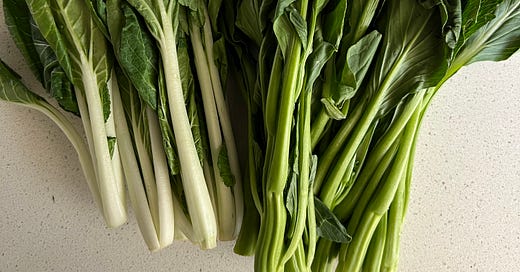


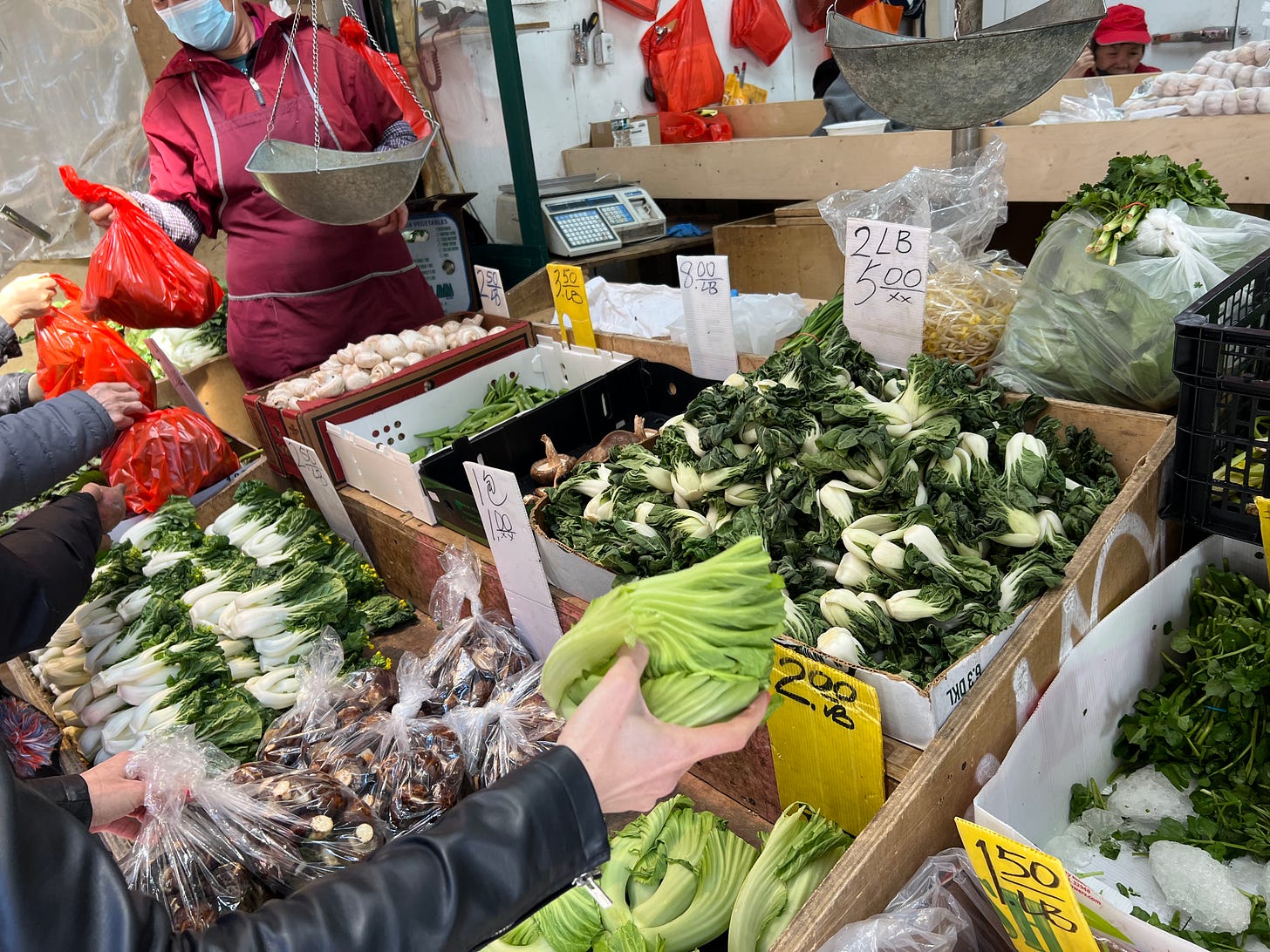

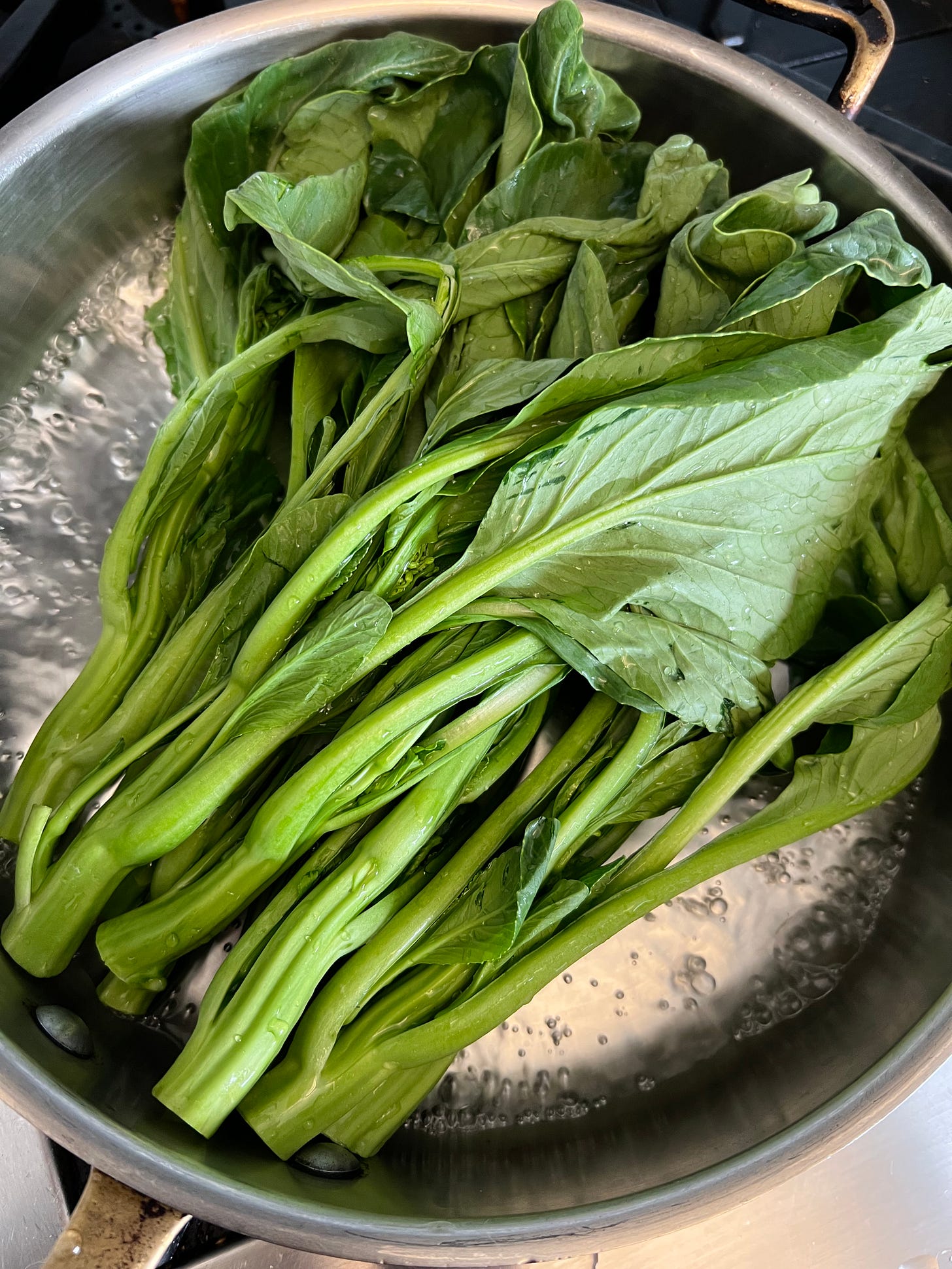
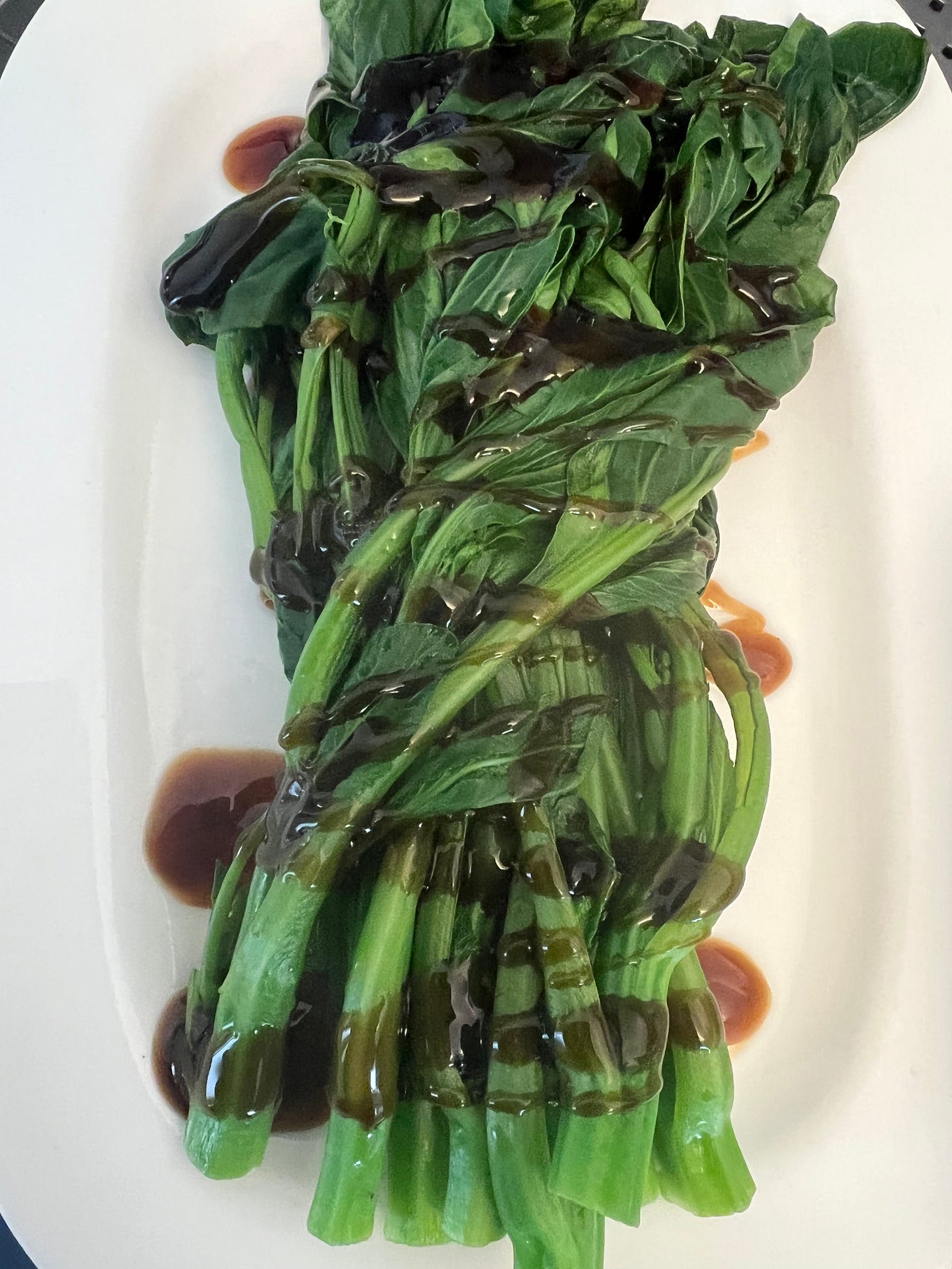
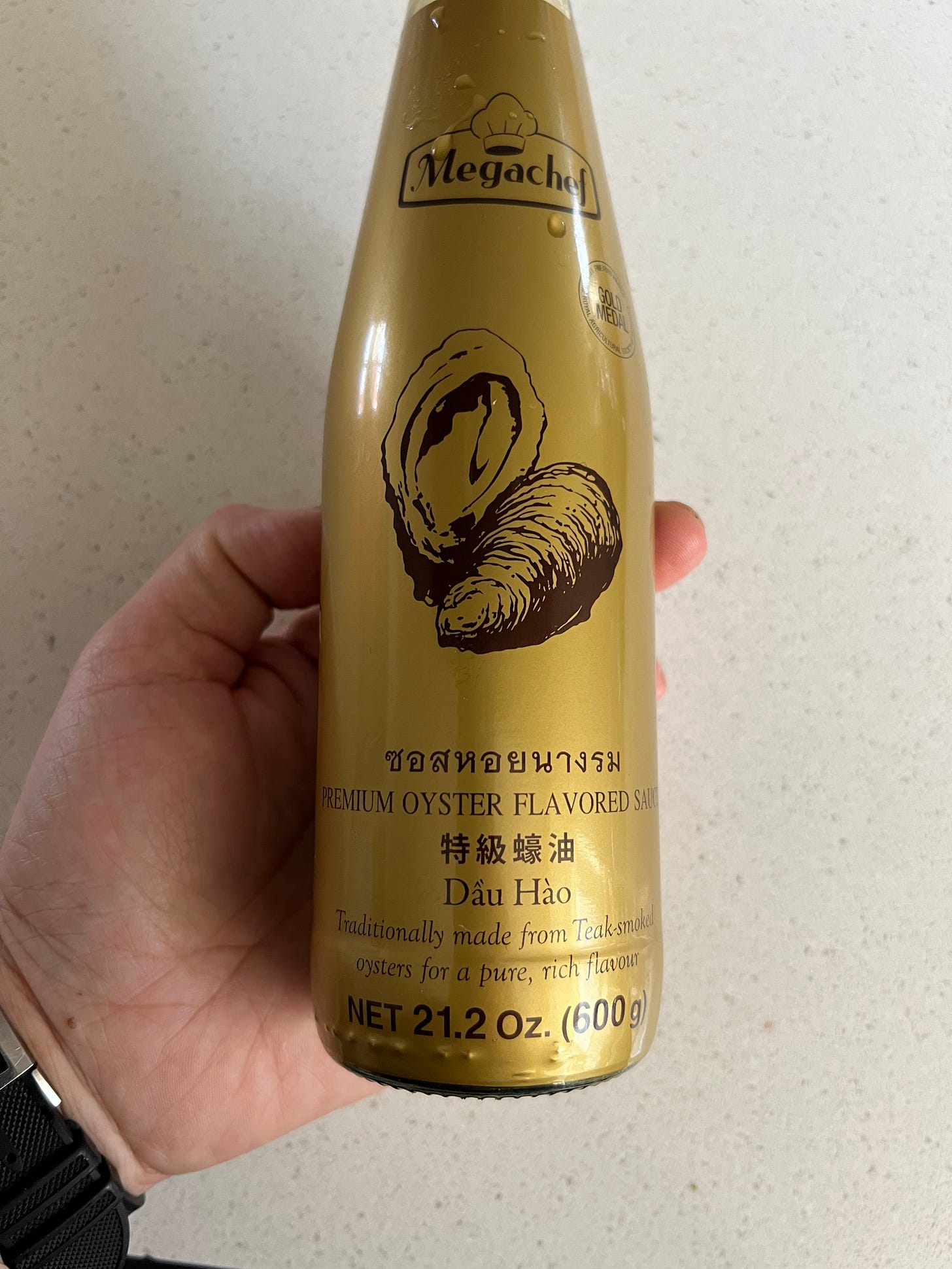


I finally found some Megachef oyster sauce! You are so right. It is spectacularly better than any other brand I've tried. Went back and bought bottles to pass out to all my family and friends. We too are big on Asian greens as the Asian markets are pretty great here in Nashville. Often steam/boil any kind of Asian greens with sauteed onion and garlic (or regular southern turnip greens for that matter) and make a soup with added miso and water. I call it miso potlikker. Add buckwheat noodles, hot pepper paste for a terrific lunch. Thank you for all the smart ideas and recipes.
Regarding your Google Map: Square map pins are indeed ads. Paid promotions.
Thanks for another great newsletter!